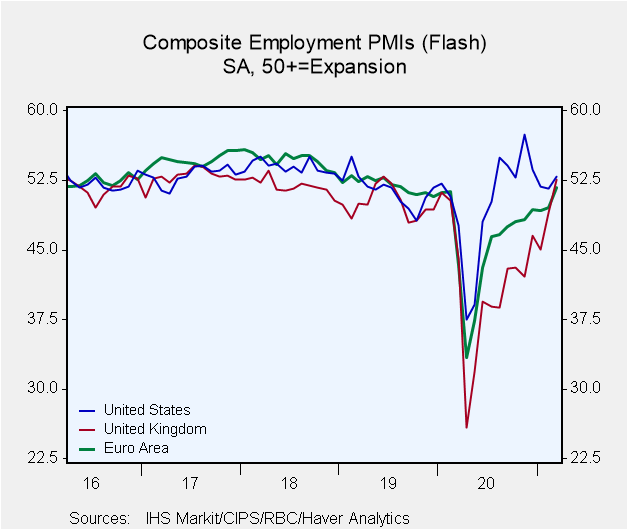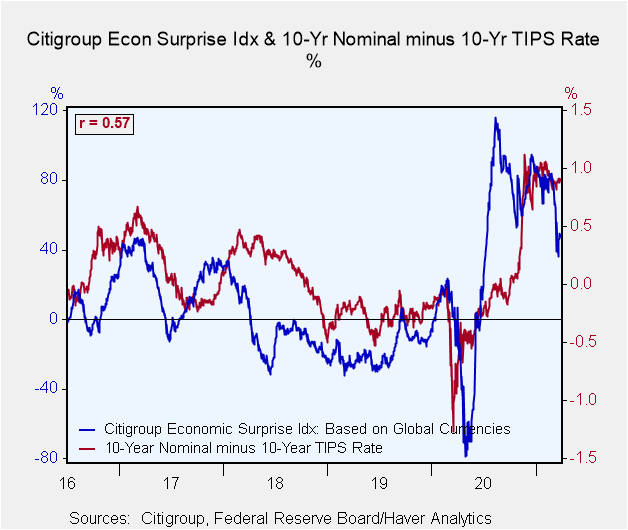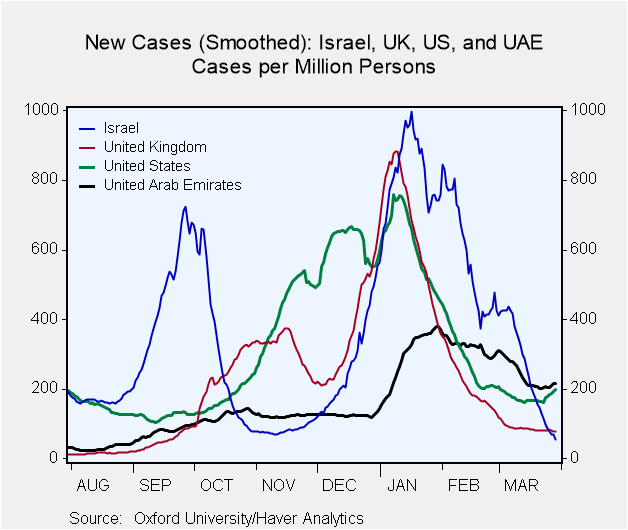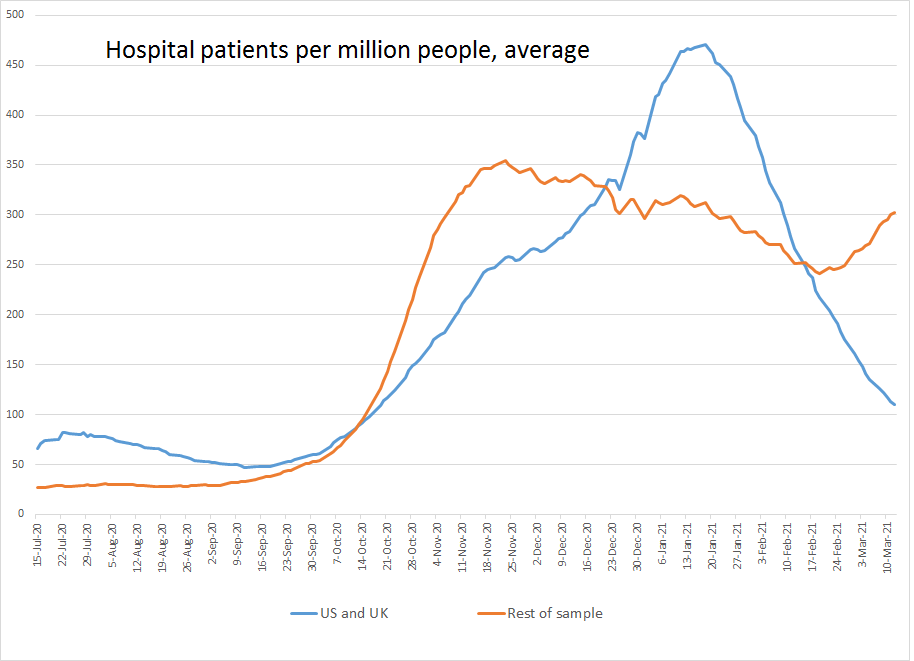 Global| Mar 30 2021
Global| Mar 30 2021Data Surprises, Markets and COVID
by:Andrew Cates
|in:Viewpoints
Summary
Incoming economic data in recent weeks have been encouraging. Forward looking indicators such as March's flash purchasing managers' surveys elicited across-the-board improvements in both manufacturing and services. Every major country [...]
Incoming economic data in recent weeks have been encouraging. Forward looking indicators such as March's flash purchasing managers' surveys elicited across-the-board improvements in both manufacturing and services. Every major country moreover that report these estimates registered a gain in their composite PMI. Even more encouragingly, employment components – which have hitherto been somewhat depressed – registered decent gains, particularly in Europe (see figure 1 below).
Figure 1: Positive employment components from flash PMI surveys
On the whole these survey results chime with other forward looking data points. Many of Europe's consumer confidence surveys, for example, rebounded sharply in March. China's combined dataflow for January and February for retail sales, industrial production and capital expenditure each registered year-on-year growth of more than 35%. And regional manufacturing surveys from the US – such as the March Philly Fed and Empire State index – have also chalked up impressive gains.
A further noteworthy feature of recent data concerns its ongoing capacity to surprise consensus forecasts positively. In truth some of the data have not been surprising forecasts on the upside as frequently as before. As figure 2 below indicates Citigroup’s global economic surprise index has moved off its highs in the opening three months of this year. Incoming data from the US and emerging economies, in particular, have not been posting positive surprises (relative to expectations) as often relative to the last few weeks of 2020.
However, positive surprises at the global level have nevertheless still been the norm. And as figure 2 further suggests, this matters for financial markets. Over the past several years equity market valuations have tended to loosely track the ebb and flow of global data surprises. So a flurry of more positive data has tended to go hand in hand with richer valuations. Equally a burst of more negative data has tended to chime with lower valuations.
Figure 2: Economic data surprises have rhymed with valuation shifts in equity markets
It's not just with equity markets, however, that data surprises have tended to rhyme. The latest run-up in US inflation expectations, for example, has also tended to track the trend toward positive data. Heightened optimism about global growth prospects, in other words, has unsurprisingly been matched by an investor response toward both the outlook for corporate earnings and inflation.
Figure 3: Economic data surprises have also tracked shifts in the market's inflation expectations
One reason for cautioning against too much enthusiasm about recent data concerns global COVID trends. Latest data from Oxford University suggest that the global daily incidence of the virus was at a relatively low level on February 20, with 358,550 new cases per day. Since that time, daily incidence has increased by nearly 50% to 528,854—a difference of 170,304 cases. For the record, Brazil and India account for 38% of the global increase over that time.
Figure 4: COVID-19 - new global cases and fatalities
However, a cursory glance at case numbers in many other countries is far more encouarging. That's because on the whole those countries that have been vaccinating their populations at a relatively hefty pace have been seeing falling case numbers. So, for example, Israel, the UK, the UAE and the US – which have vaccinated relatively heavily – have mostly seen a sharp retreat in case numbers over the past two months. In fairness, much of this is also a function of relatively stringent lockdown restrictions (e.g. in the UK). In addition, where those restrictions have lately been tapered it's notable too that a downward trend has recently come to an end (e.g. in the US).
Figure 5: New case numbers in Israel the US, the UK and the UAE
What will really matter though going forward for policy responses toward the virus – and ultimately the vigour of any global economic rebound – is the pace and breadth of a vaccine rollout together with its overall efficacy.
On the last point though, namely efficacy, matters are equally encouraging. For instance hospitalisation rates in the US and UK (which, to repeat the point, have vaccinated heavily) continue to fall very rapidly (see figure 6 below). In contrast, hospitalisation rates have either been falling less rapidly or rising in countries that have not vaccinated as heavily. Admittedly this conclusion could be partly hostage to the ebb and flow of case numbers which, in turn, might be hostage to lockdown stringency. That case numbers have continued to shrink sharply in Israel, however, where lockdown stringency has seen a material loosening and vaccination rates are higher than anywhere else in the world, offers further evidence in support of vaccine efficacy (see figure 5 above).
Figure 6: Hospital patient numbers in the US and UK are declining rapidly
Source: University of Oxford/Haver Analytics
What's the bottom line? The economic outlook remains promising in part because of the vaccination rollout and the evidence that suggests it is working. Incoming economic data tend to support this conclusion.
Glitches to this upbeat prognosis stem in part from the risks to financial stability that are lurking from higher inflation as a recovery matures and as policy responds. But as illustrated above, some of that risk seems to be more a function of incoming data that have been demonstrating an unusually high capacity to surprise forecasters on the upside.
The other glitch stems from the virus and the uneven pace at which vaccinations are being distributed around the world. The politicisation of this process in Europe (and elsewhere) alongside rising case numbers in a few of those same countries is arguably the most potent threat to a global economic revival at present. If vaccination rates step up, however, and this politicisation ebbs while case numbers, hopsitalisation rates and fatalities respond, the outlook ought to continue to improve in the period ahead.
Viewpoint commentaries are the opinions of the author and do not reflect the views of Haver Analytics.Andrew Cates
AuthorMore in Author Profile »Andy Cates joined Haver Analytics as a Senior Economist in 2020. Andy has more than 25 years of experience forecasting the global economic outlook and in assessing the implications for policy settings and financial markets. He has held various senior positions in London in a number of Investment Banks including as Head of Developed Markets Economics at Nomura and as Chief Eurozone Economist at RBS. These followed a spell of 21 years as Senior International Economist at UBS, 5 of which were spent in Singapore. Prior to his time in financial services Andy was a UK economist at HM Treasury in London holding positions in the domestic forecasting and macroeconomic modelling units. He has a BA in Economics from the University of York and an MSc in Economics and Econometrics from the University of Southampton.








